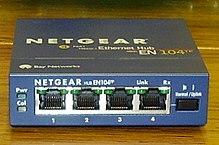Hub (network technology)
| 7th | 7th | ||||
| 6th | 6th | ||||
| 5 | 5 | ||||
| 4th | 4th | ||||
| 3 | 3 | ||||
| 2 | 2 | ||||
| 1 | 1 | 1 | |||
The hub in the OSI model

In telecommunications, devices that connect network nodes (physically) in a star shape are referred to as a hub ( English hub , technically , `` nodal point '') . Usually the abbreviation hub is used for repeating hubs . They are used to connect devices in a computer network, e.g. B. through an Ethernet .
Also sometimes just as Hub are called Bridging hubs or switching hubs , the much more common, however (not entirely correctly) as the switch are called. Although they look very similar on the outside, there are actually significant technical differences. Mix-ups are encouraged, among other things, that devices are also sold under the designation hub that operate on OSI / ISO layers 2 to 4, but a hub works exclusively on level 1 of the ISO / OSI reference model .
functionality
A repeating hub works exactly like a repeater and is therefore also called a multiport repeater . The signal of a network participant is not analyzed, only the transmitted bit or symbol level is regenerated. However , a hub usually contributes to collision detection . In contrast to the switch, which specifically looks for the recipient's ports, bits / symbols are forwarded to all other network participants (compare broadcast ). For this reason, you can also analyze or record the data traffic between network participants with network sniffers at each connection of a hub (in contrast to those of a switch) .
A hub only has connections (also called ports ) with the same speed (with the same MII , but definitely different MDI ). For example, if a hub has a BNC coupling and RJ45 connections , its speed is 10 Mbit / s half-duplex . To connect further repeating hubs or switches, either a special uplink port (also X-Port or MDI), switchable, or the same port as both an MDI-X and an MDI version is used. A crossover cable or an Auto MDI-X port on the other side is required for normal ports .
Dual-speed hubs are a special feature . Internally, they consist of a 10 Mbit / s and a 100 Mbit / s hub as well as a “store and forward bridge ”. Ports are connected to one or the other hub when a device is connected, depending on the auto-negotiation .
use
When using a hub in the network, the cabling implements a star topology in the physical sense . The logical structure is similar to that of a bus topology , because every information sent reaches all participants. All participants in a network that are connected to a hub are in the same collision domain . However, a hub increases the reliability compared to a physical bus network: The malfunction of a cable does not paralyze the entire network, but only affects a single participant, who can then no longer be reached. The fault is also easier to locate.
After the advent of switches, repeating hubs were mainly used for reasons of cost, often in combination with the latter. When switches became cheaper and cheaper around 2000, they completely pushed hubs out of the market.
Ethernet repeaters and hubs have been marked as obsolete in the IEEE 802.3 standards since 2011 and should no longer be installed.
Cascading of hubs
Repeating hubs cannot be cascaded arbitrarily in an Ethernet in order to achieve a larger network area. A maximum round trip delay time (RTDT) specific for each speed must not be exceeded. The RTDT is the time it takes for a data frame to travel from one end of the network to the most distant other end of the network and back again. If the network becomes too large, i.e. the RTDT too high, collisions become more frequent, undetected collisions are possible and the entire network traffic is impaired. Such disturbances are difficult to isolate because transmissions can function normally when the network load is low. As with repeaters, the 5-4-3 rule (10 Mbit / s Ethernet) must be adhered to or no more than two repeaters may be used (100 Mbit / s Ethernet) so that problems arise due to long signal transit times (RTDT) can be avoided. Partly because of this limitation, switches are used almost everywhere today. For Gigabit Ethernet , hubs / repeaters were initially specified in the standard, but no longer manufactured. Their use would no longer be technically possible at higher speeds.
See also
Web links
Individual evidence
- ^ University of Leipzig: Hub. Retrieved May 15, 2019 .
- ↑ a b Tech target: Network hub. Retrieved May 21, 2019 .
- ↑ Hub Ethernet. Retrieved May 15, 2019 .
- ↑ a b Electronics Compendium: Hub. Retrieved May 21, 2019 .
- ↑ IEEE 802.3 9. Repeater unit for 10 Mb / s baseband networks
- ↑ IEEE 802.3 27. Repeater for 100 Mb / s baseband networks
- ↑ IEEE 802.3 41. Repeater for 1000 Mb / s baseband networks
- ↑ IEEE 802.3 Clause 41
- ↑ PCWelt: Hub. April 22, 2019, accessed May 15, 2019 .


